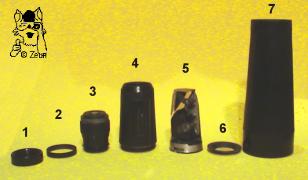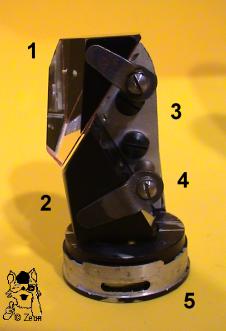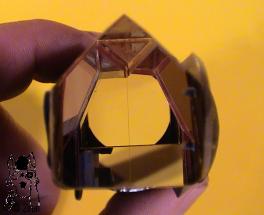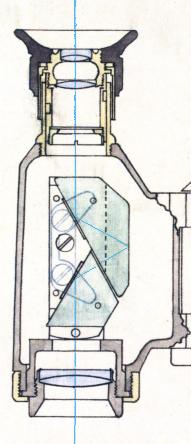Hensoldt Dialyt Bauweise und PrismensystemViele Hensoldt Monokulare (natürlich auch Ferngläser) haben eine typische Bauweise mit geraden Okulartubus und konischen Objektivtubus. |
Hensoldt Dialyt Design and Prism SystemMany Hensoldt monoculars (of course, also binoculars) show a typical design with a straight ocular tube and a conical objective tube. |
|
parts f.l.t.r.: 1) eye-cup (plastic/Bakelite), 2) distance/cover ring for the ocular thread and screws, 3) ocular system, 4) prism body, 5) prism container with rooftop prism, 6) f.o.v. shade, 7) objektive tube with lense. |
Die Zeichnung (rechts) zur Konstruktions zeigt die Anordnung des Prismensystems im Fernglas und den Strahlengang (blaue Linie hervorgehoben vom Verf.). Das Hensoldt-typische Prismensystem (Abbé-König, verwendet in den Dialyt-Gläsern) ist auf einem seitlichen Prismenträger aus Metall (3) montiert, wobei die 2 Prismen (1, 2 beim unteren Prisma sind die Flächen geschwärzt) durch angeschraubte Metalllippen (4) gehalten werden und keinen direkten Kontakt haben. Das Trägergestell (3) ist auf einem Montierungsring (5) befestigt, welcher in das Prismengehäuse geschoben und mit einer Schraube seitlich arretiert wird (s. Schlitz im silbernen Fuß).
In der Draufsicht (Foto), welche die normale Blickrichtung durch das Prisma darstellt, ist die Dachkante des ersten Prismas gut zu erkennen. Sie zeichnet sich als feiner Haarstrich im Prisma ab. |
The drawing (right) of the construction shows the positioning and the path of light (blue line from me) in the binocular. The Hensoldt typical prism system (Abbé-König, used in the Dialyt glasses) is mounted on a prism support made of metal (3). The two prisms (1, 2 the lower prism has blackened sides) are fixed by metal clamps (4) - screwed to the support - without having any contact to each other. The support (3) is fixed to a bearing disc (5). The latter is pushed all the way into the prism tube and screwed on from the side (see the slot in the silvery end). From the bird's view (photo), depicting the regular through the prism, the rooftop can be seen as a fine line. |
Ferngläser- oder Monokular-Modelle mit Abbé-König Prismen außer den Dialyten gab es nur sehr wenige, z.B. von Zeiss (s. "Noctarmo" 7x50 oder Dekar 10x50). Siehe auch Infos beim Artikel (PDF) "Wissenswertes über Ferngläser" |
Besides the Dialyts, Binoculars or monocular models with an Abbé-König prism system were quite rare, for example, some Zeiss models (s. "Noctarmo" 7x50 or Dekar 10x50)). Also see information in the article (PDF) "Wissenswertes über Ferngläser" |
Fotos: Zeun; Zeichnung adaptiert aus – (drawing adapted from): M. Hensoldt & Söhne, Wetzlar - 125 Jahre Präzision





